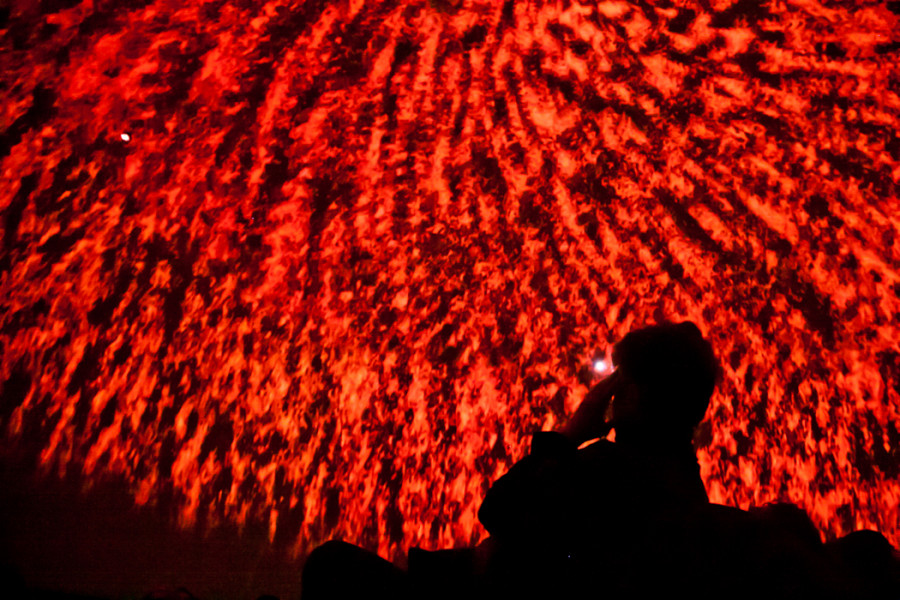Enter the SATosphere
New Exhibition P3RCEPTION at La Société des Arts Technologiques Takes Montreal for a Ride
As children, we all loved going to the planetarium and experiencing the awe-inspiring, almost magical dome theatre: submerged in an inky blackness with booming soundscapes, being transported through the cosmos by mystical celestial projections of fathomless depths.
This show is for those who want to re-capture that sense of wonder.
La Société des arts technologiques has brought the planetarium’s dome concept into the art world with its SATosphere, a colossal full-dome theatre that hosts a variety of immersive multimedia art pieces for Montreal art lovers—and inner children.
The upcoming program to be presented in it, P3RCEPTION, features three experimental works that focus on total immersion and shifting of perspectives and perceptions.
“What’s great about it is you usually have boundaries of a canvas, especially in video when you have a rectangular shape you’re composing in,” said Diana Reichenbach, one of the P3RCEPTION artists of the unique dome format.
“When you’re in the full dome, it’s like it’s endless. It’s really quite unique.”
The specs of the dome are striking. The projections are at 4K resolution, utilizing internal mapping of the sphere with eight HD projectors to produce dazzling spectacles of 80,000 lumens. To put that into perspective, your average household lamp emits between 1,500 and 1,600 lumens.
The sound system is made up of 157 speakers in clusters of four around the perimeter of the dome, giving a surround sound of 39.4 channels as opposed to the traditional home theatre set-up of 5.1.
Constructed in October 2011, the SATosphere shares a floor with Foodlab, the SAT’s gourmet restaurant.
“The idea behind it was to create a ‘sensatorium’ to reach all the senses,” said Louis-Philippe St-Arnault, director of Production and Immersive Development for the SATosphere.
“In the immersive space we get the audio-visual reaches, and in the Foodlab we get the smell-taste reaches.”
The first film in P3RCEPTION is “0.1.,” pronounced “oh-one,” by Los Angeles-based animator Diana Reichenbach. The eight-minute piece fuses the natural with the digital and creates a “hybrid poetic environment” through engagement of the two ideas.
“The idea behind the film is that you’re in a naturalistic setting, using the medium to make people feel like they’re sitting in the woods. But it’s a reveal that it’s really something digital that you’re experiencing, and it’s not natural,” said Reichenbach.
“The point is trying to express that the reality of the world as we experience it, through our senses, is also in conversation with digital media. How we see everything is really influenced by that.”
“0.1.” uses a panoramic photo of a forest as its base; a composite of 38 high resolution images to create a single forest-scape. Live-action elements and digital animation are then used to make the transition into the digital realm.
The second film in the series is “Carbon-X,” an experimental other-worldly collaboration by renowned visual FX designer Eric Hanson and Search for Extraterrestrial Intelligence’s sole artist-in-residence Charles Lindsay.
Hanson has created digital environments for films such as The Day After Tomorrow and The Fifth Element, and was also Reichenbach’s professor at the University of Southern California while she was working towards her M.F.A. in animation.
“The dome community, as you can imagine, is not very big,” she joked.
Lindsay has an impressive resume of trekking around the world for his work, from the Arctic to the southeast jungles of Asia, and is the first artist-in-residence at SETI.
“Carbon-X” attempts to open new dimensions and transport viewers to alien worlds. It uses techniques of CGI photogrammetry and particle dynamics to achieve geometric patterns and spaces, and was originally produced for the Getting Off the Planet artistic celestial exhibit in New Mexico—home of Roswell, the alleged UFO crash site.
Hemisphere, the final piece of P3RCEPTION, first premiered at the SATosphere in May 2012 and was created by German composer and multimedia artist Ulf Langheinrich.
The piece uses fractal algorithms as its audiovisual base and employs stroboscopic effects to further stimulate the senses.
“It’s a really intense experience,” said St-Arnault. “It’s not only about the visuals, it’s about your state of being when you’re in there. Towards the end I was asking myself, ‘Am I still grounded? Am I still really here?’ A very strange feeling is produced.
“I was like, ‘Ok, I didn’t take any drugs,’ but I was still asking myself that question,” St-Arnault continued. “It’s totally effective. Ulf is a master at that kind of thing.”
Hemisphere is 20 minutes long, and something St-Arnault describes as a “dense, textural, physical experience.”
P3RCEPTION hopes to emphasize the immersive qualities of the full-dome theatre and take advantage of the exceptional medium.
“With a show like P3RCEPTION, we’re expressing another kind of concept. It’s a more contemplative, un-narrated experience that you can just live in. Because it’s a spherical environment, you’re in it; you’re in the experience. It’s very physical,” St-Arnault said.
“I think the [dome format] medium needs more exposure, and there’s been a struggle in getting in art content outside of science,” Reichenbach said. “I feel really honoured to be a part of it, and I hope there’s more screenings like this in the future.”
P3RCEPTION / Satosphere, La Société des arts technologiques, (1201 St. Laurent Blvd.) / April 2 – April 26 / 7 p.m. / Film $15.00, Film + Dinner $45.00


_600_832_s.png)

_600_375_90_s_c1.jpg)
_600_375_90_s_c1.jpg)
__600_375_90_s_c1.jpg)